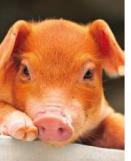Phytogenic concepts in piglets

At pig farms, the need for optimal feed efficiency, in terms of feed conversion ratios, becomes even more evident in present t imes of rising prices for feed ingredients. Phytogenics – originating from herbs and spices – can help to improve feed efficiency and animal health, says Tobias Steiner from Biomin.
Optimising feed conversion ratio is crucial for
efficiency in swine production. A trial was recently carried out at the Kansas
State University, US, to evaluate the efficacy of phytogenics in comparison to
antibiotic growth promoters (AGPs) in post-weaning piglets (Sulabo et al.,
2007).
192 piglets (22 days of age) were
assigned to four treatment groups: Group 1 was fed a negative control diet
without growth-promoters. Groups 2 and 3 received the negative control diet
supplemented with phytogenics. Group 4 was offered a positive control diet
containing AGPs (140 g/t neomycin sulfate and 140 g/t oxytetracycline HCl).
Growth performance was significantly improved over the negative control group
when phytogenics or AGPs were added to the feed. In terms of average daily
gains, the pigs fed phytogenics were intermediate between the negative control
and the AGPs. Feed conversion, however, was best in the groups receiving
phytogenics. The phytogenic feed additive* under investigation contained a
defined blend of essential oils from anise, citrus and oregano, as well as plant
extracts.
Results
It can be concluded from the outcome of this trial that
well-selected phytogenics can be successfully used to improve growth performance
in post-weaning piglets, especially in antibiotic-free feeding regimens. The
results from
conducted in
Slagterier also
showed an increase in performance when the feed was supplemented with
phytogenics. In this trial, 384 pigs (5 weeks of age) were fed either a negative
control diet or the negative control diet with supplemental phytogenics*. The
feed was pelleted at a minimum temperature of 81°C.
Performance parameters, as recorded from weaning to 50 days post-weaning, are
shown in Table 1. Not only daily gain and feed conversion ratio were improved by
5.2 and 4.5%, respectively. Also the Danish Production Value was increased by
10.3% through supplementation of the feed with phytogenics. The Danish
Production Value represents an indicator of productivity and is calculated as
follows: (kg gain × DKK/kg gain)–(no. of analyzed FUp ×
DKK/FUp), with figures being based on average local prices. Results from a field
trial conducted in
South
Africa
showed substantial benefits of
phytogenics in weaned pigs. The trial was carried out on a commercial farm and
lasted 37 days. Pigs in group A (control) were fed a basal diet containing Tylan
(1 kg/t) and zinc oxide (4 kg/ t), whereas pigs in group B were fed the basal
diet supplemented with phytogenics. As shown in Table 2, considerable
improvements in daily weight gain were seen when the pigs were fed phytogenics.
Moreover, pigs in group B were more uniform in size at the end of the
trial.
Conclusion and
outlook
Well-investigated phytogenics are an efficient tool to support animal
health and growth performance. Since they do not pose any risk regarding
antibiotic resistance or residues in animal products such as meat, eggs or milk,
phytogenics are expected to gain high consumer’s acceptance and are generally
regarded as safe alternatives to AGPs.
however, has to be paid on the composition of formulations which are available
in the market. Only a well-balanced and scientifically developed combination of
active ingredients with different properties can be expected to function
synergistically in order to bring about the desired benefits for the producer.
However, phytogenic feed additives usually vary seriously in their chemical
composition. Hence, there are large differences in efficacy between phytogenic
products in the market. A big challenge for swine producers is to find the
suitable product formulation out of an increasing number of phytogenic feed
additives which are available.
*The phytogenic feed additive is available under
the product name Biomin® P.E.P. Literature is available from the author on
request (tobias.steiner@biomin.net
)
Source: Feed Mix Magazine Volume 16 No.
4











